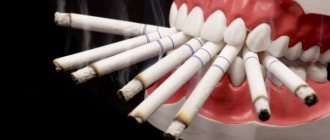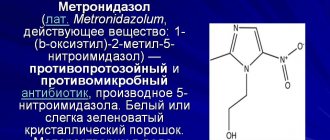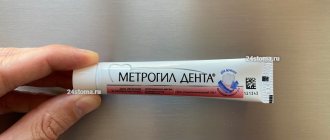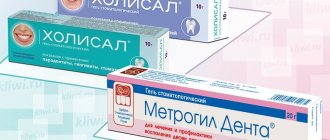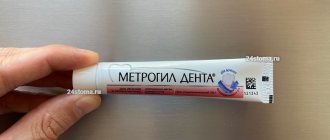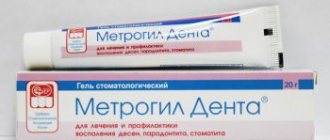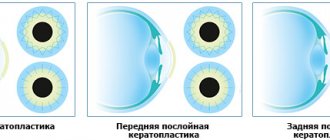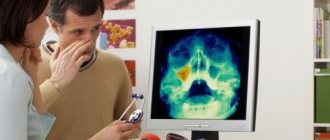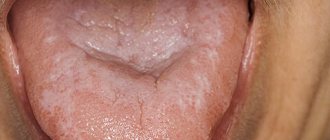Gum inflammation is accompanied by a number of painful symptoms that not only affect your well-being, but also affect your ability to chew and speak normally. To eliminate unpleasant signs in dentistry, special gels are used. They act directly on the oral mucosa and are slightly absorbed into the blood, which makes them safe for children.
Painkillers and anti-inflammatory gels can be used during teething (Baby Doctor) and for complex treatment of gingivitis or stomatitis.
Indications for use of dental gels
The dentist may prescribe the gel to a child or adult when there are signs of gum inflammation. The reason for using the gel will also be stomatitis, which affects not only the gums, but also the entire oral mucosa.
Dental gel will help with the following symptoms and diseases:
- pain, burning, redness along the edge of the tooth crown;
- bleeding gums after chewing hard foods and brushing teeth;
- thrush, fungal stomatitis or oral candidiasis;
- glossitis (inflammation of the tongue) and papillitis (inflammation of the dental papilla);
- teething in a child;
- growth of wisdom teeth, which is accompanied by gum damage.
The medicine can only be used topically. The gel is applied to the affected areas of the mucous membrane up to 4 times a day, according to the instructions. After treating the gums, it is recommended not to eat anything for several hours, and not to drink for at least half an hour, so as not to wash off the drug. Before applying, be sure to rinse your mouth with an antiseptic or regular mouthwash.
Some types of gels are homeopathic remedies, therefore, in case of severe inflammation and pain they will be ineffective (Malavit), others have a strong anti-inflammatory and analgesic effect. There is a large selection of dental gels; it is important to understand how they differ, and which one is better for a particular problem.
Similar drugs:
- Augmentin Oral tablets
- Tea tree DN Ointment for external use
- Augmentin Powder for suspension for oral administration
- Bactrim Oral suspension
- Dioxydin Mouth rinse solution
- Pancef Oral tablets
- Nifuroxazide (Nifuroxazide) Oral tablets
- Cifran OD Oral tablets
- Pancef Granules for the preparation of suspension for oral administration
- Augmentin ES Powder for oral solution
** The Drug Directory is intended for informational purposes only. For more complete information, please refer to the manufacturer's instructions. Do not self-medicate; Before starting to use the drug Metrogyl Denta, you should consult a doctor. EUROLAB is not responsible for the consequences caused by the use of information posted on the portal. Any information on the site does not replace medical advice and cannot serve as a guarantee of the positive effect of the drug.
Are you interested in the drug Metrogyl Denta? Do you want to know more detailed information or do you need a doctor's examination? Or do you need an inspection? You can make an appointment with a doctor - the Euro lab is always at your service! The best doctors will examine you, advise you, provide the necessary assistance and make a diagnosis. You can also call a doctor at home . Euro lab clinic is open for you around the clock.
** Attention! The information presented in this medication guide is intended for medical professionals and should not be used as a basis for self-medication. The description of the drug Metrogyl Denta is provided for informational purposes and is not intended for prescribing treatment without the participation of a doctor. Patients need to consult a specialist!
If you are interested in any other drugs and medications, their descriptions and instructions for use, information about the composition and form of release, indications for use and side effects, methods of use, prices and reviews of drugs, or you have any other questions and suggestions - write to us, we will definitely try to help you.
Which gel is better?
A well-known representative is Dental. This is an anti-inflammatory gel; it contains corn oil, which promotes the formation of a protective barrier on the mucous membrane, which allows damaged cells to recover faster and prevent complications.
It is recommended to use Dental up to 4 times a day, applying it in a thin layer to the entire surface of the inflamed gum. This drug will also help those who are faced with denture stomatitis. The drug accelerates regeneration, reduces inflammation and relieves pain.
Parodium is another good remedy for inflammatory diseases of the oral mucosa. It is both an antiseptic and has an anti-inflammatory and hemostatic effect. Indicated for the treatment of periodontitis, gingivitis, traumatic and bacterial stomatitis.
Kalgel and Baby Doctor are one of the safest products for children during teething. They relieve pain, cool the gums, and begin to act almost instantly. Their only drawback is the short duration of pain relief; they can relieve unpleasant symptoms for up to 30 minutes.
The most well-known representatives, which are most often recommended by dentists, are the gels Metrogyl Denta, Asepta, Cholisal, Solcoseryl and Kamistad.
Metrogyl gel is a reliable product in dentistry
Metrogyl Denta is a dental medicinal product produced by pharmaceutical companies in the form of a gel. Thanks to the combined composition, including:
- antibiotic;
- antiseptic,
- the medicine has a wide spectrum of antimicrobial action and is recommended by experts for use by both adults and children over 6 years of age.
The main active ingredients of the drug are metronidazole and chlorhexidine.
Metronidazole, known for its antimicrobial properties, is successfully used in medicine for:
- peptic ulcers;
- chronic colitis;
- inflammation of the urinary system;
- genital infections,
- as well as for the purpose of preventing complications that often arise after surgery.
Chlorhexidine is an effective antiseptic used in medical practice:
- during preoperative treatment of hands;
- when cleaning medical premises;
- for disinfection of instruments.
Thanks to its gel consistency, Metrogyl is successfully used in dentistry, but in addition, the product can help solve some cosmetic problems and stop the inflammatory processes of the external genitalia.
Metrogil:
instructions for use
In dental practice, the drug is used to treat:
- gingivitis;
- periodontitis;
- bacterial stomatitis;
- lip inflammation;
- inflammatory processes of the hoods over wisdom teeth;
- inflammation of the mucous membrane;
- alviolite of the socket of an extracted tooth,
- It is also used as an additional agent in the treatment of periodontitis and periodontal abscess.
However, despite the effectiveness of Metrogyl, the instructions of which recommend its use for these diseases, an experienced doctor may prescribe other drugs, depending on the individual characteristics of the patient’s body and the complexity of the case.
Metrogyl denta goes on sale in laminated plastic tubes of 20 grams and is sold without a prescription.
Metrogyl, reviews of which from experts allow us to recommend to patients a relatively inexpensive and effective antiseptic drug, is often used as an everyday means of oral hygiene, which helps prevent many inflammatory processes.
Metrogil Denta
Contains an antibacterial substance - metronidazole and an antiseptic - chlorhexidine. It is used to relieve gum pain during stomatitis, after dental treatment, during an inflammatory process due to infection or traumatic injury.
The gel is practically not absorbed, therefore it is safe for treating the oral mucosa of a child. But at the same time, the low concentration of the active ingredient makes it not the most effective against severe inflammation; after treatment, there may be a relapse.
Application benefits
Despite the rather low concentration of active substances and the lack of analgesic effect, Metrogyl Denta gel has a number of advantages over more modern drugs used in medicine, for example:
- the drug is perfectly fixed on the mucous membranes;
- has a fairly high efficiency,
- In addition, its affordable cost allows you to regularly use this product for preventive purposes.
The active components of the drug allow you to influence pathogenic microorganisms, but are not able to block mediators of inflammatory processes in tissues, therefore, in the treatment of many diseases, experts recommend combined procedures to achieve a more effective result.
Solcoseryl
One of the most popular gels in dentistry is Solcoseryl. This remedy is classified as a medicine (while many others act as balms), therefore it is recommended by dentists for the treatment of such unpleasant pathologies as oral candidiasis, viral, traumatic and necrotizing ulcerative stomatitis.
Solcoseryl gel will help get rid of pain; the active ingredients in its composition stimulate metabolic processes in the affected tissues, which accelerates regeneration.
Defects of the oral mucosa and what they may indicate
There may be several reasons for such changes, but only a qualified doctor can determine what is wrong and make an accurate diagnosis.
Changes in the mucous membrane may indicate pathology:
- gastrointestinal tract;
- immune system;
- endocrine system;
- general intoxication of the body.
As a result, defects appear on the surface of the oral mucosa - ulcers and erosions. All these elements of the lesion cause discomfort to the patient.
In this case, consultation with a specialist is necessary - a therapist, gastroenterologist and endocrinologist.
But defects in the mucous membrane are often very painful and interfere with normal nutrition and speech in everyday life. In this case, healing and local anesthetic agents for local use are necessary. One of such effective drugs is Metrogyl Denta.
Symptoms
1st half of pregnancy.
Typically, symptoms of gingivitis occur in the 3-4th month of pregnancy, since during this period intense hormonal changes occur, leading to the development of the catarrhal form of the disease. Gingivitis manifests itself as follows:
- bleeding gums;
- pain when brushing teeth;
- swelling of the marginal part of the gums and gingival papillae;
- change in gum color (first redness, then blueness).
2nd half of pregnancy.
Inflammation, accompanied by swelling and bleeding, worsens. The gingival papillae and marginal gums may begin to grow. This type of gingivitis is called hypertrophic. It is especially pronounced in the area of the front teeth and in places where there are overhanging edges of crowns and fillings that injure the gums. Hypertrophic gingivitis comes in two forms:
- edematous – the gingival papillae enlarge, become blue in color, become soft to the touch, have polypous growths or a loose structure;
- fibrous – the gingival papillae enlarge and at the same time become dense.
Up to contents
What do the two gels have in common?
All forms of release have a similar broad antimicrobial range of action . The drugs destroy protozoa - the causative agents of trichomoniasis, amoebiasis, giardiasis. Infections caused by rod-shaped microorganisms - bacteroides, fusobacteria, clostridia, peptococci, peptostreptococci - are highly sensitive to therapy with these drugs.
A number of researchers talk about the presence of antioxidant properties, that is, the drug prevents tissue damage from free oxygen molecules.
